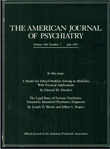Misuses and Misunderstandings of Boundary Theory in Clinical and Regulatory Settings
Abstract
OBJECTIVE: This paper outlines a number of misapplications of boundary theory in both regulatory settings and clinical situations. METHOD: The authors review clinical vignettes that illustrate the difference between boundary crossings, which lead to productive work in psychotherapy, and boundary violations, which are harmful to the patient and exploit the patient's vulnerable position. They also discuss developments in the field that have led to an excessively rigid and defensive posture on the part of some clinicians that may lead to less than optimal psychiatric treatment. They survey recent developments in the wording of state statutes that broadly define sexual misconduct in psychotherapy. RESULTS: This review of the current status of boundary theory in both the law and clinical practice suggests that an overreaction has occurred that requires correction. CONCLUSIONS: The critical role of context must be considered whenever a boundary problem has been alleged, and boundaries must be regarded as flexible standards of good practice rather than lists of generically forbidden behavior.



